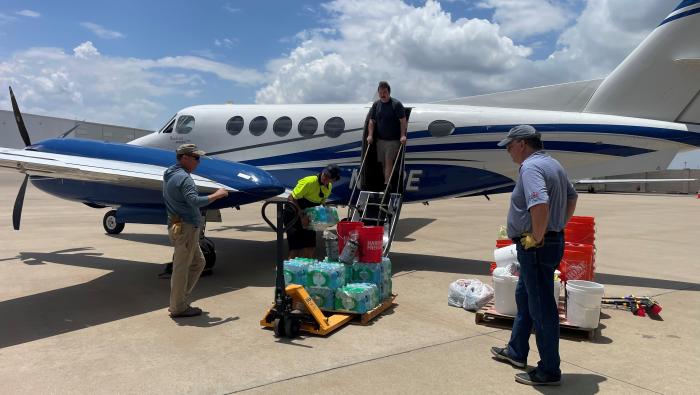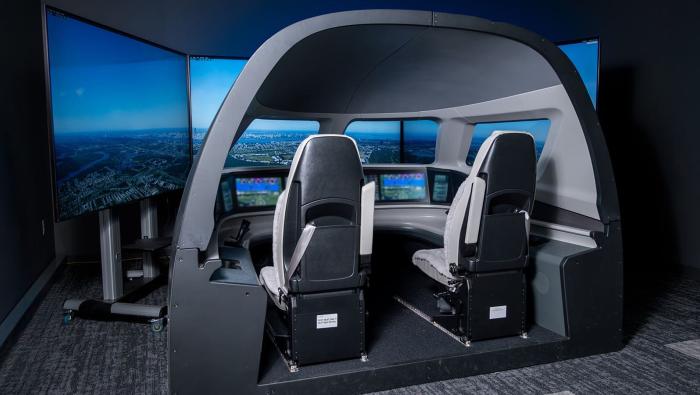
Following the devastating flooding in Texas on Friday that claimed at least 100 lives with scores of people still missing, business aviation operators have swung into action to deliver critical supplies to those affected in Kerr County and the Guadalupe River area. Leading the effort is Operation Airdrop, a Texas-based disaster relief nonprofit founded in 2017 by a group of aviation enthusiasts, and part of NBAA’s Humanitarian Emergency Response Operator (HERO) database.
Operation Airdrop established supply bases at the Commemorative Air Force Museum at Burnet Municipal Airport (KBMQ) near Kerrville and at the Million Air FBO at Dallas-area Addison Airport (KADS) to accept donated goods and equipment. Among the items in high demand are tools such as chainsaws and shovels, cleaning supplies including mops and brooms, and N95 face masks. All of the donations will be consolidated at KBMQ and distributed within the impacted area.
In the wake of the slashing of budgets of FEMA and other emergency response agencies by the current administration, Airlink, another aviation charity, is working to transport volunteer search-and-rescue crews to the region by leveraging its partnerships with airlines such as United, American, JetBlue, and Southwest. With more rain forecast for the area this week, the Washington, D.C.-based group has thus far transported nearly 100 volunteers to help fill the urgent need for rescue, emergency management planning, recovery, and clean-up.
|
Global business aircraft flight activity jumped 4.8% year over year (YOY) in June, with North America up 3.7%, and Europe by 2.4%, according to aviation safety and data specialist Argus International. This sets the stage for continued improvement this month, with Argus anticipating a 1.8% YOY increase in North America and a 1.5% rise in European activity in July.
Citing its TraqPak data, Argus noted that strengthened North American operations in June exceeded the projected 1.1% increase for the month, with operational categories up across the board. Fractional activity continued to drive the increases, up 9.4% YOY in North America, followed by Part 135, up 2.8%, and Part 91, up 2.1%.
In North America, all categories trended positive last month, with light jets leading the way at a 5.7% YOY increase, followed by large-cabin jets at 3.5%, and midsize jets and turboprops each with 2.9% gains. While fractional operations have surged for some time, Part 135/charter activity is now up 1.9% in the first half, Argus reported.
In Europe, operations were up for the second month in a row with large-cabin jets showing the largest increase at 6.2%, followed by midsize jets at 3.4%. However, not all aircraft categories posted gains: operations involving turboprops were down 0.2% YOY and light jets fell by 0.5% in June.
|
Bombardier says it is on track to open an aircraft paint facility at London Biggin Hill Airport (EGKB) during the second half of 2026. The airframer yesterday reported that the foundations for the new 51,000-sq-ft hangar are in place, and progress has been made constructing the steel framework and cladding for the structure.
The paint shop is part of Bombardier’s existing service center at Biggin Hill. The 250,000-sq-ft facility opened in 2017 and was expanded in 2022. Last year, in partnership with aircraft interiors specialist F/List, Bombardier added a cabin materials lounge where customers can make design choices.
On July 4, Peter Fortune, the member of UK Parliament for Bromley and Biggin Hill, visited the service center, which supports Global, Challenger, and Learjet aircraft. The two-bay paint facility will employ 50 skilled technicians.
“The addition of the new paint facility at the London Biggin Hill Airport adds a sought-after service element to the already comprehensive offerings for our customers, ensuring they have a complete maintenance experience to help keep their aircraft in the air,” said general manager Sander Podgoric. He added that the operation supports “hundreds” of well-paid jobs in the local community.
Last year, Bombardier installed more than 3,000 solar panels on the roof of the facility, which is in southeast London. It also operates a line maintenance station on the west side of the UK capital at Farnborough Airport (EGLF).
|
Honeywell continues to add more procedures to its FMS guided visual (FGV) approach series while coming up with new features such as all chart information on one page, installation in flight simulators, and integration of the FGV content pack into the ForeFlight Mobile app.
Nearly 600 customers are using Honeywell’s FGVs, and there are now about 20 of these approaches available, including some for non-U.S. airports. More are being added, and Honeywell has hired additional personnel to speed up the process of creating FGVs.
Airlines have been using FGVs for decades, but they weren’t used by business aircraft operators on a wide scale until Honeywell began developing them for its customers. Anyone could develop FGVs for their own flight operation’s use, but the process requires specialized knowledge—for example, NetJets has developed its own set of approaches for its exclusive use.
Honeywell's FGV database, which is available for a variety of Honeywell avionics-equipped aircraft, costs $2,000 per year per aircraft. The idea behind FGVs is to mitigate the risk of flying visual approaches to runways that are constrained by obstacles or operational restrictions, or have other risky characteristics. An example is Honeywell’s first FGV an alternative to the Teterboro Airport (KTEB) ILS Runway 6 circle to Runway 1 visual approach.
|
Sponsor Content: RTX
Semi-autonomous software systems can help with manual tasks and cognitive calculations, freeing pilots to focus on critical thinking and decision-making. Collins Aerospace, an RTX business, has been developing and testing those systems.
|
Cornwall, UK-headquartered helicopter maintenance and services company Castle Air Group has acquired Heliwork Services, which is based in Thruxton.
The Heliwork purchase adds more capabilities to Castle Air’s menu, including advanced blade repairs and component overhauls. In addition to base and line maintenance and CAMO services, Castle Air provides AOG support, parts sourcing, flight training, charter, and rotorcraft sales and leasing.
“We are delighted to welcome Heliwork Services into the Castle Air family,” said Ross Bunyard, managing director. “Their strong reputation and technical expertise make them a perfect fit for our organization. This acquisition not only broadens our service offering but also reinforces our commitment to delivering the highest standards of helicopter support across the industry.”
“Joining Castle Air Group marks an exciting new chapter for Heliwork Services,” said Nigel Guppy, commercial director at Heliwork Services. “With the combined strengths of our teams, we’re well-positioned to deliver even greater value to our customers through enhanced capabilities and continued engineering excellence.”
|
Cessna Citation owners will be able to have Gogo Galileo half-duplex (HDX) low-earth-orbit (LEO) satcom systems installed in their jets at Textron Aviation’s service centers. Installations will be available after FAA supplemental type certificate (STC) approval for Citations, which is expected later this year.
Models covered by the STCs will include the Citation X/X+; Sovereign/Sovereign+; Latitude; Excel/XLS/XLS+/XLS Gen2; CJ4/CJ4 Gen2; CJ3/CJ3+; CJ2/CJ2+; and CJ1/CJ1+/M2/M2 Gen 2. The installation consists of an HDX electronically-steered antenna mounted on top of the fuselage and the Gogo Avance router. The HDX antenna is designed for smaller airframes and measures 24 by 11.8 by 2 inches and weighs 21.6 pounds. Gogo Galileo provides high-speed, worldwide internet access on the Eutelsat OneWeb LEO satellite constellation.
“Our customers expect to stay connected and productive while in the air, and integrating the Gogo Galileo HDX system ensures they have access to high-speed internet in-flight,” said Brian Rohloff, Textron Aviation senior v-p, global customer support. “This advanced connectivity solution underscores our commitment to providing our customers with cutting-edge technology that enhances their flying experience.”
|
Milestone Aviation Group and Leonardo have signed a framework agreement that covers the leasing company’s fleet of more than 100 Leonardo helicopters. It includes a “streamlined power-by-the-hour transition solution” for the Milestone fleet, the companies said. The power-by-the-hour solution is designed to benefit Milestone customers flying Leonardo AW139s, AW169s, and/or AW189s.
“This agreement serves as a renewed affirmation of the enduring and robust relationship between Leonardo and Milestone—a strategic partnership that has consistently yielded successful outcomes over the years and reflects the culmination of several months of close and productive collaboration between both organizations,” said Francesco Bellardi, Leonardo's v-p customer support and services. “This agreement not only solidifies the foundation of mutual trust and cooperation but also lays the groundwork across Leonardo’s global operations.”
According to Milestone Aviation head of fleet and technical operations Kieran Hannan, “Milestone and Leonardo have worked closely together for almost 15 years, and we are proud to count more than 100 AW169, AW139, and AW189 aircraft in our fleet. This agreement underscores our ongoing commitment to collaborating with Leonardo to deliver their aircraft to our customers across a diverse range of missions, including offshore operations, SAR, EMS, and the renewable energy sector.”
|
RECENT AIRWORTHINESS DIRECTIVES
- AD NUMBER: Brazil ANAC 2024-02-02R1
- MFTR: Embraer
- MODEL(S): Legacy 450/500 and Praetor 500/600
- Cancels and supersedes AD No. 2024-02-02 and is being issued to include a flight control computer software update and airplane flight manual revision as terminative actions for an unsafe condition involving the AOA limiter. Prompted by a report of a hard landing event with substantial damage to the airplane, in which the AOA limiter was engaged in the final approach phase, in unstable air conditions, and remained engaged until the aircraft's touchdown on the runway. If the AOA limiter remains active during the final approach phase when the landing flare is commanded, pitch response may be reduced during a critical phase of flight near the ground, and in unstable air conditions, it may result in a high rate of descent landing and possible subsequent structural damage of the airplane on landing.
| PUBLISHED: July 8, 2025 |
EFFECTIVE: July 14, 2025 |
- AD NUMBER: Transport Canada CF-2025-36
- MFTR: Bombardier
- MODEL(S): Challenger 604
- Revises six non-destructive testing manual procedures (NDTM) and adds eight new NDTM procedures.
| PUBLISHED: July 8, 2025 |
EFFECTIVE: July 22, 2025 |
- AD NUMBER: EASA 2025-0142
- MFTR: Leonardo Helicopters
- MODEL(S): A109A
- Requires a one-time inspection of the cyclic control system's pitch and roll actuators attaching bolts, verification of the direction of their installation, and any necessary corrective action(s). AD also prohibits the use of maintenance instructions providing potentially misleading part installation instructions.
| PUBLISHED: July 7, 2025 |
EFFECTIVE: July 21, 2025 |
- AD NUMBER: FAA 2025-12-07
- MFTR: Airbus Helicopters
- MODEL(S): AS332C
- Requires revising the airworthiness limitations section of the maintenance manual or instructions for continued airworthiness and the approved maintenance or inspection program, as applicable.
| PUBLISHED: July 7, 2025 |
EFFECTIVE: August 11, 2025 |
- AD NUMBER: Transport Canada CF-2025-35
- MFTR: Bell
- MODEL(S): 505
- Follows emergency AD CF-2025-17, which prohibited installation of the ballast weights in the aft ballast box while a terminating action was developed. This AD implements a ballast box modification as a terminating action to allow use of the ballast weights to resume. It also corrects an error in the kit part number in the applicability section. Prompted by the discovery of possible plastic deformation and/or improper pin engagement in the knuckles of the door hinge on the aft movable ballast box assembly. Ballast weights escaping the ballast box have a high potential of striking the tail rotor assembly, resulting in damage and/or departure of tail rotor blades, loss of tail rotor thrust, and severe vibrations that would lead to loss of control of the helicopter.
| PUBLISHED: July 4, 2025 |
EFFECTIVE: July 18, 2025 |
- AD NUMBER: Transport Canada CF-2025-34
- MFTR: Bell
- MODEL(S): 505
- Requires a one-time inspection of the tail rotor pitch link assemblies for proper installation of a certain washer. If the washer is improperly installed, the pitch link and washer must be removed and reassembled in the correct order, unless there is evidence of contact between the pitch link and either the conical washer or the tail rotor blade pitch horn, in which case the affected parts must be replaced.
| PUBLISHED: July 3, 2025 |
EFFECTIVE: July 17, 2025 |
|
 |
|
AINalerts News Tips/Feedback:
News tips may be sent anonymously, but feedback must
include name and contact info (we will withhold name on request). We reserve the
right to edit correspondence for length, clarity, and grammar. Send feedback or
news tips to AINalerts editor Chad Trautvetter.
|
AINalerts is a publication of AIN Media Group, 214 Franklin Avenue, Midland Park, New Jersey. Copyright 2025. All rights reserved.
Reproduction in whole or in part without permission is strictly prohibited.
|
|















